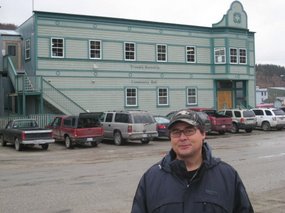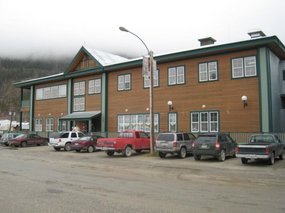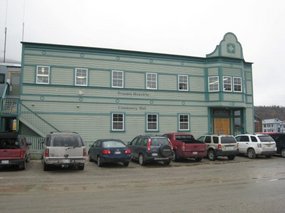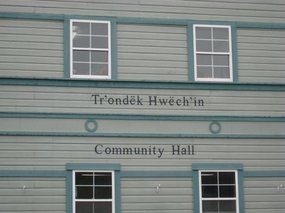Check out Lobo on YOU TUBE:
•••••••••••••••••••••••••••••••••••••••••••••••••••••••••••••••
www.youtube.com/user/travelswithlobo
**********************************************************
Dawson City - The Han -
(Tr'ondek Hwech'in) "People of the Klondike River"
Today's blog goes back about 40,000 years to a time when there was a temporary land bridge between Siberia and the North American continent allowing for the migration of people from Asia to the Americas.
Some 10,000 years ago this migration went as far as the tip of South America.
These massive time frames for the existence of the earth are ironic because last evening I attended a lecture at the beautiful campus of the University of Northern British Columbia here in Prince George.
The original purpose of going there was to attend a presentation on Guatemala. When that lecture was cancelled, I inadvertently stumbled into a lecture on "How the Ice Age was caused by the Genesis Flood". This was presented by a group called the Northwest Creation Network whose aim is to make a case for creation through the use of science. Therefore, scientific evidence was presented to demonstrate that the ice age was caused by the climatic chaos of the Genesis Flood. This would conform to the Biblical chronology of the earth being about 6,000 years old.
The main scientific research is summarized at the hyperlink below. When you get to the page do a search for "helium"
http://www.answersingenesis.org/creation/v20/i3/old_earth.as p
(Disclaimer: I am not espousing any point of view in citing this information. I am simply a curious individual and any new information or viewpoint on an issue is of general interest to me)
The 6,000 years stand in sharp contrast to the 40,000 years cited for the Beringia landbridge between what is now Siberia and Alaska.
It does illustrate the huge diversity of opinions and conjectures that separate people from one another, often with dire consequences. These consequences can only be avoided through respect and an open mindedness that accepts the diversity so evident around us.
Among the nomadic hunters that crossed the Beringia landbridge was a group of people known as the Athapaskans.
Distinguished from other native groups by their language characteristics, their territory in Northwestern North America extended as far south as New Mexico.
The Athapascans in turn were divided among many native groups. One of those groups is the Han people.
At its peak, their population extended throughout central Alaska and the Yukon, whereas today they live only in Dawson City, Yukon and Eagle, Alaska.
The translation of Han is "people of the river". Because of their attachment to the river life, they were semi-nomads who alternated between fishing for salmon during season and otherwise hunting game as a means of survival in a harsh northern climate.
Some characteristics of early Han life were:
- children worked at an early age in the gathering of food
- arranged marriages
- cross-clan marriage
- passage from childhood to adulthood for girls marked by a year of seclusion
- a boy's first kill of game celebrated by the men of the village
- if a spouse died, remarriage would not take place for a number of years
- in times of hunger, the very young and the very old were abandoned or strangled
- infanticide was practiced for female children
- belief in a rich spirit world
- the Shaman was the middle man (woman) between the ordinary person and the spirit world
- the Shaman was the source of knowledge in love, war, hunting and illness
- belief in same-sex reincarnation
- potlatches (feasts) associated with birth, puberty and death all had religious significance attached to them
Early Contact Period
The first European contact with the Han was in the 1700's with Russian fur traders and in 1840 with Hudson Bay traders.
The early trading period was the zenith of the Han culture as the fur trade brought prosperity. However, they were also decimated by epidemics against which they had no immunity.
The Han were adversely affected by the Gold Rush as it infringed on their traditional hunting grounds. In 1896, the Han moved from the Klondike area to the Government Reserve near Dawson City.
In 1900, a 160 acre site known as Moosehide was set aside for the Han near Dawson City.
Assimilation into white society continued after the gold rush. Changes in lifestyle reduced contact between groups of Han since the aboriginal life style was under continual erosion.
By 1932, the Han considered themselves to be residents of only two remaining areas: Moosehide near Dawson City and Eagle, Alaska.
In 1957, the maintaining of a separate school at Moosehide was considered too expensive which resulted in the abandonment of Moosehide in favour of the Han moving to Dawson City. Here their children went to a common school system. The two groups: the Han and the Caucasian population were thus integrated.
My superficial account of Han history does not take into account all the difficulties, hardships, and prejudices suffered by the Han over the years in their contacts with white society.
The erosion of a people, a culture, and a way of life over many years cannot occur without grave consequences resulting in historic grievances and mistrust.
Much of this mistrust is played out in the context of land claim negotiations between various First Nation bands such as the Han and the federal and provincial governments.
To date there has been no Yukon native land claim settled.
So is it all hopeless?
Not according to Chief Darren Taylor of the Han people of Dawson City.
Did it take me a long time to arrange an interview with this bright articulate young man?
No, I happen to return to the site of the ferry crossing at the Yukon River when I struck up a conversation (topic now forgotten) with the only person who was there at the same time.
It turned out to be Chief Darren Taylor who was standing on the ancestral banks of the Yukon across from his domain.
His domain in this case was the striking Band offices and Community Center just across the street.
Expecting to see the name Han written on the buildings, I was confused by the name Tr'ondek Hwech'in which appeared instead.
As the chief's own website: http://www.cyfn.ca/dyncat.cfm?catid=88 explains. "Han" this is a linguistic term which recently has been replaced by the term "Tr'ondek Hwech'in", which means, the people of the Klondike River.
The official name now is: Tr'ondek Hwech'in Han Nation
I was impressed with this articulate, youthful, vigorous leader of the Tr'ondek Hwech'in.
With Chief Darren Taylor, I am sure that stereotypes have been broken. If first impressions mean anything, this man was well equipped to lead his people in an intelligent and assured manner into the future.
I got the impression that his style of dealing with various levels of government would be one of quiet negotiation as opposed to strident confrontation.
Under his leadership, the Tr'ondek Hwech'in population is now growing. Just as important is the development of an economy under the auspices of Chief Isaac Inc. a division of the Dawson Indian Band.
Under the auspices of Chief Isaac Inc. and the help of $350,000 from the Federal Economic Development Fund, 45% ownership interests have been bought in Kluane Freight Lines Ltd. and Mckenzie Petroleum leading to the creation of 21 jobs.
http://www.ainc-inac.gc.ca/nr/prs/m-a2003/2-02302_e.html
Han Fisheries is another example of a successful business endeavor. In addition, there are plans for future tourist development in the area.
The Yukon government is also making its contribution in the form of funding for initiatives in the preservation and growth of Han culture through the native language education program. Another project is the restoration of the Moosehide site.
The most poignant remark that Chief Darren Taylor made was that the band provided employment for a number of non Han residents of Dawson City.
To Chief Darren Taylor and to the office staff, thanks for the comments and information provided.
------------------------------------------------------------ ----------------------------
Most of the information in this blog about the Han people came from the pamphlet "Han Indians - People of the River" published by Dawson Indian Band 1988, compiled and presented by Kathy Kosuta
Dawson City - The Han - "People of the River"
Tuesday, September 25, 2007
 Dawson City, Yukon, Canada
Dawson City, Yukon, Canada
Other Entries
-
45Seward to Homer - The Kenai Peninsula - Part 13
Sep 1510 days prior Homer, United Statesphoto_camera170videocam 0comment 0
Homer, United Statesphoto_camera170videocam 0comment 0 -
46Glenn Highway - Anchorage to Glennallen
Sep 187 days prior Glennallen, United Statesphoto_camera35videocam 0comment 0
Glennallen, United Statesphoto_camera35videocam 0comment 0 -
47Richardson Highway - Glennallen to Valdez
Sep 196 days prior Valdez, United Statesphoto_camera119videocam 0comment 0
Valdez, United Statesphoto_camera119videocam 0comment 0 -
48Trail of the Whispering Giants: Peter Wolf Toth
Sep 205 days prior Valdez, United Statesphoto_camera5videocam 0comment 0
Valdez, United Statesphoto_camera5videocam 0comment 0 -
49Wrangell - Saint Elias National Park- Part 1 of 4
Sep 205 days prior McCarthy, United Statesphoto_camera45videocam 0comment 0
McCarthy, United Statesphoto_camera45videocam 0comment 0 -
50Wrangell - Saint Elias National Park - Part 2 of 4
Sep 223 days prior McCarthy, United Statesphoto_camera69videocam 0comment 0
McCarthy, United Statesphoto_camera69videocam 0comment 0 -
51Wrangell - Saint Elias National Park - Part 3 of 4
Sep 223 days prior Kennecott, United Statesphoto_camera65videocam 0comment 0
Kennecott, United Statesphoto_camera65videocam 0comment 0 -
52Wrangell - Saint Elias National Park - Part 4 of 4
Sep 223 days prior Kennecott, United Statesphoto_camera64videocam 0comment 0
Kennecott, United Statesphoto_camera64videocam 0comment 0 -
53Tok Junction and a Second Chance
Sep 223 days prior Tok, United Statesphoto_camera67videocam 0comment 0
Tok, United Statesphoto_camera67videocam 0comment 0 -
54Top of the World Highway to Dawson City
Sep 223 days prior Dawson City, Canadaphoto_camera42videocam 0comment 0
Dawson City, Canadaphoto_camera42videocam 0comment 0 -
55Dawson City and the Klondike Gold Rush
Sep 223 days prior Dawson City, Canadaphoto_camera61videocam 0comment 1
Dawson City, Canadaphoto_camera61videocam 0comment 1 -
56A Third Chance: This One I Could Not Refuse
Sep 232 days prior Dawson City, Canadaphoto_camera2videocam 0comment 0
Dawson City, Canadaphoto_camera2videocam 0comment 0 -
57Dempster Highway - The Essentials
Sep 232 days prior Dawson City, Canadaphoto_camera18videocam 0comment 0
Dawson City, Canadaphoto_camera18videocam 0comment 0 -
58Dempster Highway - The Drive to Eagle Plains
Sep 241 day prior Fort McPherson, United Statesphoto_camera69videocam 0comment 0
Fort McPherson, United Statesphoto_camera69videocam 0comment 0 -
59Dempster Highway - The Push to the Arctic Circle
Sep 241 day prior Fort McPherson, United Statesphoto_camera49videocam 0comment 0
Fort McPherson, United Statesphoto_camera49videocam 0comment 0 -
60Dempster Highway - Inspector William Dempster
Sep 25earlier that day Fort McPherson, United Statesphoto_camera1videocam 0comment 1
Fort McPherson, United Statesphoto_camera1videocam 0comment 1 -
61Dempster Highway - North to Inuvik?
Sep 25earlier that day Fort McPherson, United Statesphoto_camera62videocam 0comment 2
Fort McPherson, United Statesphoto_camera62videocam 0comment 2 -
62Dawson City - The Han - "People of the River"
Sep 25 Dawson City, Canadaphoto_camera4videocam 0comment 1
Dawson City, Canadaphoto_camera4videocam 0comment 1 -
63Another Day at the Office
Sep 261 day later Dawson City, Canadaphoto_camera18videocam 0comment 0
Dawson City, Canadaphoto_camera18videocam 0comment 0 -
64Whitehorse: Robert J. Sawyer: Mr. Science Fiction
Sep 261 day later Whitehorse, Canadaphoto_camera17videocam 0comment 0
Whitehorse, Canadaphoto_camera17videocam 0comment 0 -
65Whitehorse - Frank Turner and the Yukon Quest
Sep 272 days later Whitehorse, Canadaphoto_camera46videocam 0comment 3
Whitehorse, Canadaphoto_camera46videocam 0comment 3 -
66Whitehorse: How I Lost It
Sep 272 days later Whitehorse, Canadaphoto_camera1videocam 0comment 0
Whitehorse, Canadaphoto_camera1videocam 0comment 0 -
67South to Alaska
Sep 283 days later Whitehorse, Canadaphoto_camera78videocam 0comment 0
Whitehorse, Canadaphoto_camera78videocam 0comment 0 -
68Paying Hommage to the Historic Chilkoot Trail
Sep 294 days later Skagway, United Statesphoto_camera48videocam 0comment 0
Skagway, United Statesphoto_camera48videocam 0comment 0 -
69Strategizing in Skagway
Sep 294 days later Skagway, United Statesphoto_camera56videocam 0comment 0
Skagway, United Statesphoto_camera56videocam 0comment 0 -
70Juneau - The Unique Capital of Alaska
Sep 294 days later Juneau - the Unique Capital of Alaska, United Statesphoto_camera93videocam 0comment 0
Juneau - the Unique Capital of Alaska, United Statesphoto_camera93videocam 0comment 0 -
71Sitka - Steeped in History
Oct 027 days later Sitka, United Statesphoto_camera35videocam 0comment 0
Sitka, United Statesphoto_camera35videocam 0comment 0 -
72Catching the Alaska Ferry to Ketchikan
Oct 027 days later Ketchikan, United Statesphoto_camera100videocam 0comment 0
Ketchikan, United Statesphoto_camera100videocam 0comment 0 -
73Passage to Prince Rupert
Oct 049 days later Prince Rupert, Canadaphoto_camera9videocam 0comment 0
Prince Rupert, Canadaphoto_camera9videocam 0comment 0 -
74Prince Rupert - The New Container Port
Oct 049 days later Prince Rupert, Canadaphoto_camera46videocam 0comment 0
Prince Rupert, Canadaphoto_camera46videocam 0comment 0 -
75Heading Home to Prince George
Oct 049 days later Prince George, Canadaphoto_camera31videocam 0comment 0
Prince George, Canadaphoto_camera31videocam 0comment 0 -
76Alaska / Yukon - THE EPILOGUE
Oct 0510 days later Prince George, Canadaphoto_camera0videocam 0comment 0
Prince George, Canadaphoto_camera0videocam 0comment 0 -
77Hawaii - Preparing for the Trip
Dec 1581 days later Prince George, Canadaphoto_camera3videocam 0comment 2
Prince George, Canadaphoto_camera3videocam 0comment 2 -
78Hawaii - How Not to Leave on a Trip
Dec 1682 days later Prince George, Canadaphoto_camera0videocam 0comment 0
Prince George, Canadaphoto_camera0videocam 0comment 0 -
79Waikii Beach - Getting Familiar
Dec 1783 days later Honolulu, United Statesphoto_camera49videocam 0comment 0
Honolulu, United Statesphoto_camera49videocam 0comment 0 -
80Waikiki Beach - Scream and Stomp
Dec 1884 days later Honolulu, United Statesphoto_camera4videocam 0comment 0
Honolulu, United Statesphoto_camera4videocam 0comment 0
Comments
2025-05-22
Comment code: Ask author if the code is blank

 Dawson City, Yukon, Canada
Dawson City, Yukon, Canada





Marci25Barrett
2010-06-16
I strictly recommend not to hold off until you get enough amount of cash to
order goods! You can get the business loans or just secured loan
and feel yourself free